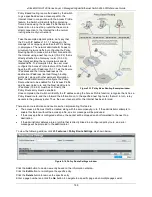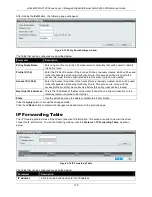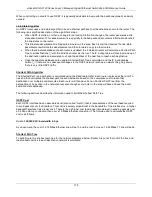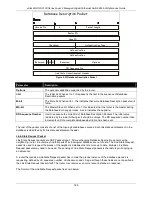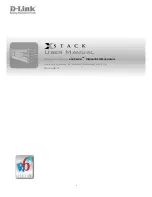
xStack® DGS-3120 Series Layer 3 Managed Gigabit Ethernet Switch Web UI Reference Guide
178
When constructing a network to use OSPF, it is generally advisable to begin with the backbone (area 0) and work
outward
Link-State Algorithm
An OSPF router uses a link-state algorithm to build a shortest path tree to all destinations known to the router. The
following is a simplified description of the algorithm’s steps:
•
When OSPF is started, or when a change in the routing information changes, the router generates a link-
state advertisement. This advertisement is a specially formatted packet that contains information about all
the link-states on the router.
•
This link-state advertisement is flooded to all routers in the area. Each router that receives the link-state
advertisement will store the advertisement and then forward a copy to other routers.
•
When the link-state database of each router is updated, the individual routers will calculate a Shortest Path
Tree to all destinations
with the individual router as the root. The IP routing table will then be made up of
the destination address, associated cost, and the address of the next hop to reach each destination.
•
Once the link-state databases are updated, Shortest Path Trees calculated, and the IP routing tables
written
if there are no subsequent changes in the OSPF network (such as a network link going down)
there is very little OSPF traffic.
Shortest Path Algorithm
The Shortest Path to a destination is calculated using the Dijkstra algorithm. Each router is placed at the root of a
tree and then calculates the shortest path to each destination based on the cumulative cost to reach that
destination over multiple possible routes. Each router will then have its own Shortest Path Tree (from the
perspective of its location in the network area) even though every router in the area will have and use the exact
same link-state database.
The following sections describe the information used to build the Shortest Path Tree.
OSPF Cost
Each OSPF interface has an associated cost (also called “metric”) that is representative of the overhead required
to send packets over that interface. This cost is inversely proportional to the bandwidth of the interface (i.e. a higher
bandwidth interface has a lower cost). There is then a higher cost (and longer time delays) in sending packets over
a 56 Kbps dial-up connection than over a 10 Mbps Ethernet connection. The formula used to calculate the OSPF
cost is as follows:
Cost = 100,000,000 / bandwidth in bps
As an example, the cost of a 10 Mbps Ethernet line will be 10 and the cost to cross a 1.544 Mbps T1 line will be 64.
Shortest Path Tree
To build Router A’s shortest path tree for the network diagramed below, Router A is put at the root of the tree and
the smallest cost link to each destination network is calculated.
Summary of Contents for xStack DGS-3120 Series
Page 1: ......






